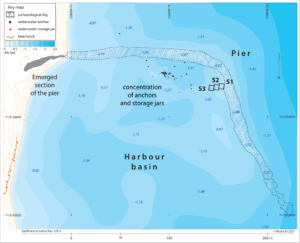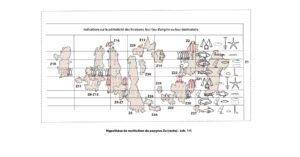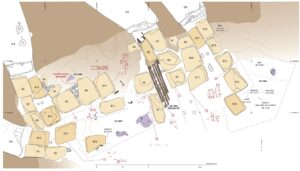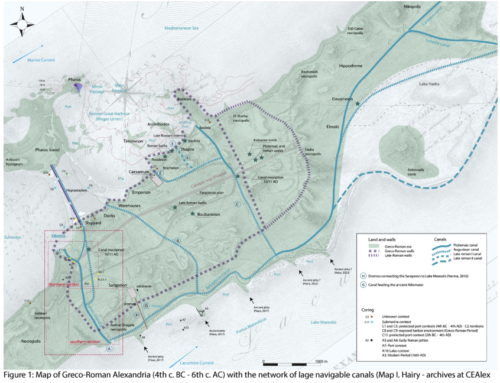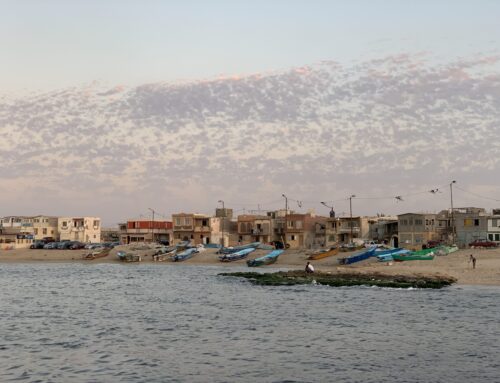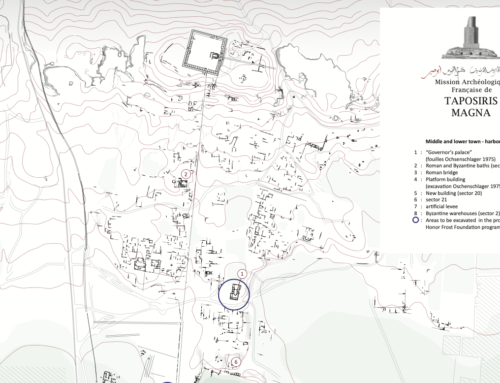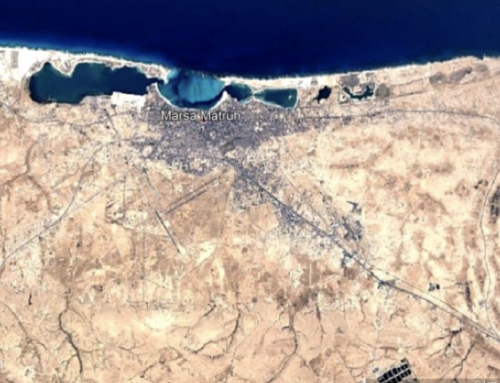Wadi el Jarf Archaeological Mission – ongoing
Prof Pierre Tallet

General view of the entrances to storage galleries G24-28, to the north
The Wadi el-Jarf project aims to study the various aspects of an Ancient Egyptian harbour on the Red Sea shore (Suez Gulf), built during the reign of Khufu, around 2600 BCE. The site is divided over several locations – a storage area, consisting of galleries cut in the mountain about 6 km to the west of the seashore, several camps and dwelling places, and a large L –shaped pier (200 x 200 m), oriented to the north, that was built directly on the sea, and which probably represents the oldest artificial sea harbour so far known in the world. The project started in 2011, and we excavated both the caves area and different installations on the seashore including a camp about 200 m away from the sea, where 100 stone anchors from the Old kingdom were found in 2013. For the 2019 season, we continued the excavation of the caves system and the study of a big square building (57 x 33 m) which is most probably an administrative building linked to the harbor – during the 2018 campaigns, levels dated to the reign of Snefru, predecessor of Khufu, were found there, showing that the occupation of the site is slightly older that previously thought. We will make some additional excavations on the camps where the anchors have been found in 2013, to have a more precise datation of its occupation (to try to identify material predating the reign of Khufu). In the meantime, a team of divers from the Ministry of Antiquities of Egypt will work in the harbour basin for the third season, if the authorization to work is given to them (last year, this operation had to be cancelled for security reasons at the last moment). The knowledge of all the components of this site – and of the connection that exist between them, will help define more precisely the main features of a harbour at the beginning of the pharaonic era.
Objectives for 2020 – 2022
- Over the next three years, the Wadi el-Jarf site excavations will focus on the following:
Structures of “Phase 1” beneath the “Intermediary Building” – preliminary plan
The excavation of the galleries which contain abundant material, will be continued. A first system of caves was thoroughly excavated. The excavation of a second group of caves was undertaken in 2018-2019 and is expected to continue over the next three years. These caves were used to store boats – some of whose remains are regularly uncovered during the excavations – but also abundant material including fabrics, stone tools, copper tools, ceramics, tissues and other objects of everyday life. It is still possible to find papyri in this area over the next few years. - The study of the quarry area which is near the galleries, identified in 2017, will also be conducted in the coming years. This is the area from which large blocks of limestone were extracted to close the galleries. Their fine analysis will allow us to identify the processes used by the Egyptians during this period to cut the stone, detach the blocks and transport them over several hundred meters, according to processes similar to those involved in the construction of the pyramids.
- The excavations of the various camps of the site will also be continued, allowing the study of the daily life of the members of the teams who were present on the site during the IVth dynasty. Those well-stratified excavations also allow for a more detailed dating of the various levels of occupation of the site, and in particular to identify its oldest period under the reign of Snefru, the founder of the IVth Dynasty. Organic material from the site will also be used for C14 dating, under the responsibility of Anita Quiles, from the French Institute of Archaeology, Cairo. Preliminary results already point out that the chronology of the IVth dynasty is probably much earlier than it was thought before.
- Finally, the study of the maritime installations of the harbour will continue, with the collaboration of a team of divers of the Ministry of Antiquities of Egypt, who have already worked three times in the framework of our mission (2016, 2017, 2019), and who studied the underwater vestiges near the L-shaped jetty.
The ninth campaign of the archaeological mission to Wadi el-Jarf ran from 10 March to 5 May 2019. Work was conducted simultaneously on three separate sites. One part of the team continued studying the site’s complex of storage galleries, while another continued the excavation, for the fourth consecutive year, of the large rectangular building located midway between the coastal zone and the mountain zone (Intermediary Building, Zone 5). Some additional work was also conducted on excavations of the seashore installations, near the jetty. In addition, a team from the Egyptian Ministry of Antiquities working in partnership with the mission undertook a third excavation campaign in the port basin from 20 April to 5 May. The examination of the transport and positioning techniques applied to the limestone blocks that sealed the system of storage galleries, which had begun last year under the supervision of Emmanuel Laroze and Franck Burgos, was also continued during this campaign.

Our knowledge of the Wadi el-Jarf site has improved considerably over this last campaign. One of the most spectacular advances is due to the study conducted this year by Claire Newton on the paleobotanical remains collected over several years from the different parts of the site. This analysis has provided important details regarding the foodstuffs allocated to the teams who populated the port of Wadi el-Jarf, and this data complements and confirms information drawn from accounts found on papyri on site. At the same time, analyses of the wood remains have provided surprises. While the identification of cedar and pine was expected, these species having been known in Egyptian nautical construction for a long time, the identification of chestnut wood in this context is evidence in this period of more complicated exchanges that are not limited to contacts with the Levantine coast. Even more important in the study of the site, the presence of ebony, sometimes unworked, is the first indication of the use of Wadi el-Jarf port as a departure point for southern regions of the Red Sea from whence such species could be imported. The ongoing analyses of resinous products discovered in large quantities in the galleries might also provide important information on this point.

A detailed analysis of the final closure and abandonment of the galleries has led to a more precise understanding of the conditions of temporary closing and reopening of these storage spaces, while confirming the existence of at least two distinct phases of use. The latest observations of the two ensembles of galleries during excavation have proved promising since they seem to show that, in contrast to what we have long thought, the galleries were not systematically emptied by the Egyptians when the site was definitively abandoned, and that at least some of them remained closed with their original contents, even if this material was ultimately disturbed and damaged by erosion of the tunnels, infiltration of water, and occasional looting. And lastly, the continued examination of the different installations located between the modern road and the coastline is providing new data on the workings of the port itself (potential identification of an assembly and launching point of the craft) and a better understanding of the original installation period on the site of Wadi el-Jarf. Examination of the first occupation level in Zone 5 has meant that we can now clearly attribute this to the reign of Sneferu.
Click here to read the full report on the 2019 underwater campaign
In 2020, the excavations were led on three distincts sectors : the area of the storage galleries, the “intermediate building”, and the shore installations.
— On the galleries area, we started the excavation of 4 of the rock-cut magazines out of the 11 that belong to the second set of galleries. Thousands of sherds of storage jars were found inside, which were systematically inscribed to the names of the teams that were using it. The full corpus of those inscriptions will allow us, at the end of the program, to evaluate the impact of those various teams of sailors on the site.
— The excavation of “zone 5” allowed both the study of a vast building 57 m long and 32.50 m across, probably in operation / in use under Cheops (phase II) and reoccupied in its abandonment levels under the reign of Chephren (phase III). This building itself is built over/atop a previous occupation of the site (phase I), which we attribute to the reign of Snefru on the basis of two fragmentary seal imprints discovered at this level. The excavation of this ancient phase, began in 2018, continued into 2020, making it possible to identify the whole northern extension of this older occupation (fig. 1). Scribal equipment was found there.
— Finally, we re-excavated the exceptional deposit of 100 boat anchors, which were discovered in 2013, still stored in the space between two camps about 200 m from the sea hore (fig. 2). This operation was intended to improve their photographic coverage, but was also an opportunity to carry out a more systematic registration of the marks written on these anchors by the teams that stored them there (fig. 3). The corpus of these could thus be brought, at the end of the campaign, to a set of 70 documents, consisting of 32 “red marks”, essentially naming the boats to which these anchors belonged (fiig. 4), as well as the teams that were assigned to them, and 38 “black marks” – drawn for the most part by means of a piece of charcoal – identifying phyles and sections which are the subdivisions of these same teams . This corpus thus allows us to obtain an image of the last fleet of Cheops which frequented the place – before the final closure of these seaside buildings. As part of the preparation of the publication of this deposit, detailed drawings of a dozen of these anchors was made, thanks to the grant from the Honor Frost Foundation (fig. 5).
The eleventh campaign of the Wadi el-Jarf archaeological mission took place from March 14th to April 20th, and from September 12th to October 15th, 2021. Due to the health crisis, the number of mission members had to be reduced to a minimum again this year. Despite everything, three areas of the site have been partly excavated during the course of these field operations: the G18-28 gallery sector ; the littoral zone (zone 6) which has been the subject of final verifications; and the “intermediate building” zone, the documentation of which has been continued.
- The intervention in the G18-G28 cave area concerned five galleries (G24, G25, G26, G28A and B, fig. 2) whose entrances and closure system had been excavated in 2019 and 2020. The excavation of these five stores was completed and the anthropogenic deposits testifying to the last state of occupation were able to be analyzed in their entirety. The excavation of stores G27 and G18 also continued with the release of the thick layer of colluvium covering the archaeological levels, in order to prepare their study during the next campaign in March-April 2022. Two additional campaigns could now be sufficient to complete the recognition of all the galleries stores on the site.
- We also excavated a small intermediate station, located 1.1 km from the intermediate building, 1.07 km from the coast. The three installations are also perfectly aligned, as if their position had been determined by a sighting. This is a building made in a very careful way of stones bonded to clay, whose construction technique is very similar to that of the intermediate building (fig. 11) Closed to the north and open at its southern end, it measures 14.6 m long (in its north-south extension) and 6.80 m wide (in its east-west extension).
- A series of checks were carried out on the seaside camps, which had mainly been excavated during the 2013 and 2014 campaigns. All the anchors that were stored in those camps were restored, and systematically weighed – their average weight is 200 kg, with great disparity between individuals, whose mass varies between 350 and 50 kg. The total weight represented by the deposit is of the order of 20 tons (or 5 tons for each of the four ships that the epigraphy has enabled us to identify). The last checks focused on the area to the east of the “north building”, where a set of bakeries and kitchens have been identified, and on the area corresponding to the southwest corner of the south building. In this last sector, the removal of a late cell that covered the building from the time of Cheops made it possible to highlight the oldest occupation dating from the reign of Snefrou. This corresponds to a lighter implantation, made of wooden pillars (which have left traces in the bedrock) and materials such as canvas or branches.
The underwater mission took place in April / May. They made test pits at the bottom of the harbour and identified 4th dynasty sherds and fragments of wood. The full report of this work is forthcoming but two interim reports are included here:
The ship timbers of Ouadi el-Jarf – E. Nantet
For the excavations on the landed part of the site, another mission was led in September / October. This included excavation of Gallery G20 (33.50 m long). This is the only gallery which opens on the western side of the wadi. Its closing system, which had clearly been disrupted, was cleared in 2017 and the first few meters of its extension excavated in 2019. This initial work immediately revealed that the place had been looted relatively recently: a square shaft measuring 1.77 x 1.73 m (P1) opens in the geological floor of the gallery 2.75 m from its entrance. An iron peak set into the wall allowed descent into the excavation, and candle wrappings dating back to the 1990s had been collected in the vicinity. Rubble dumps were also visible along the entire length of the gallery, the floor of which had also been systematically dug up over the last ten metres. By the end of the 2022 campaign, the layer of colluvium and rubble had been levelled along the entire length of the gallery, where the floor could be intact, over an extension of around twenty meters. The complete excavation of this last section was carried out during this campaign. The result was disappointing: cleaning the last layer of clay above the geological ground showed that it had literally been scraped away over its entire length, and that no archaeological material was still in place.The Wadi el-Jarf excavation campaign for 2024 is scheduled to begin in March-April, for about 5 weeks. It should focus on the following areas:
- Underwater excavations mission, with a team of Egyptian divers from the MoTA in Alexandria.
- Study of the gallery-storage complex. Two galleries remain to be excavated (galleries G18 and G21). Gallery G18 is now ready for a systematic excavation of the archaeological layer, which has seen no recent disturbance and was sealed under almost two metres of colluvium. In 2017, excavation of the front part of the gallery revealed the presence of a large number of pieces of wood, unfortunately in a very poor state. Gallery G21 is currently undergoing painstaking excavation of its upper layers, which should continue throughout this campaign, with the excavation of its archaeological levels scheduled only for 2025.
At the same time, the study of material from this entire storage system should continue: study of fabrics and ropes (D. Garmi), study and documentation of storage jars (A. Bats, M. Barrière, F. Notter-Truxa), study of wood – including boat wood (E. Nantet, G. Erschenbrenner). - Experimental archaeology should also continue, with the study by F. Burgos and E. Laroze on the cutting and transportation of the limestone blocks used to close the storage system. At the same time, a second quarry where these blocks were extracted should be excavated and a study of the potters’ kilns found there carried out.
- Final checks will have to be carried out on the site’s “intermediate building” (zone 5), which included Snefru’s installations underlying the construction of the building. In particular, a survey should be carried out on the west face of the building, to check that there are no older occupations there.
- Finally, excavation of the last major complex on the site (zone 4) is due to begin: these are the largest camps, located on a rocky eminence some 500 m from the gallery area.
